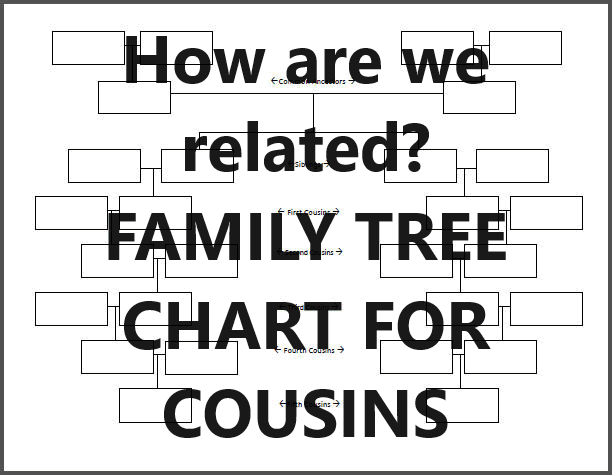| Family Tree Chart for Cousins |
| www.studenthandouts.com ↣ Graphic Organizers ↣ Graphic Organizers: Relationships |
 |
  |
|
For you hardcore genealogists out there, this family tree chart is a real treat. Commonly, in genealogy, researchers connect with third, fourth, and fifth cousins. Making sense out of these distant familial relationships can be confusing and difficult. This chart is designed to show the relationship between up to six generations that are descended from a common couple.
Completing the rest of the chart should be simple. You simply keep filling out the boxes with the names of the couple for that row, then their child's name below. Next to the child's name, place the name of that child's spouse/partner. Once the chart is complete, you can see at a glance how you and your "cousin" are related. The term "cousin" is synonymous with (the same as) "first cousin." Your "cousin" or "first cousin" is the son or daughter of your aunt or uncle (your mom or dad's brother or sister). The next generation are called "second cousins." For example, you and your first cousin each have daughters. These two little girls are second cousins. But what about generations on different rows? This is where the genealogical term "removed" is used. Your daughter and your cousin's daughter are second cousins. But how are you related to your cousin's daughter? She is your "first cousin once removed." The word "removed" refers to the fact that she is "removed" from being your first cousin by the distance of one generation. You would also be referred to as her first cousin once removed. The formula for "removed" cousins is to start with the earliest relationship, then count down the number of generations from which the two people are "removed." For example, imagine that the chart above features "Pierre" on the horizontal row of second cousins, and "Marguerite" on the horizontal row of fifth cousins. They are second cousins removed by three generations. Pierre and Marguerite would refer to one another as "second cousins thrice (three times) removed." Pierre's wife, not a blood relative of Marguerite, would be her "second cousin-in-law thrice removed." Click here to print or download this chart. |
| www.studenthandouts.com ↣ Graphic Organizers ↣ Graphic Organizers: Relationships |








